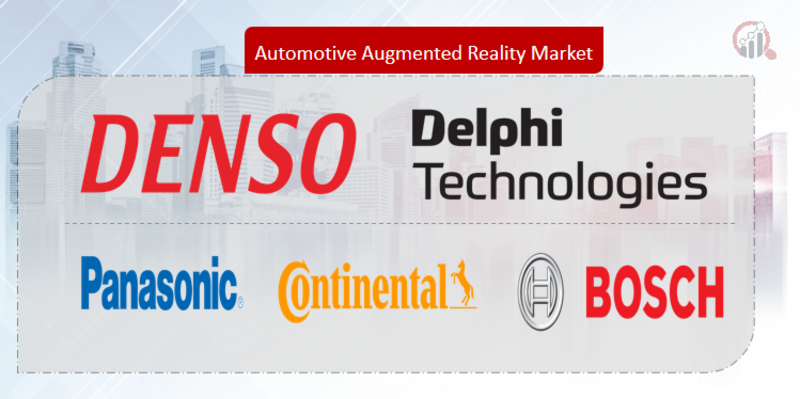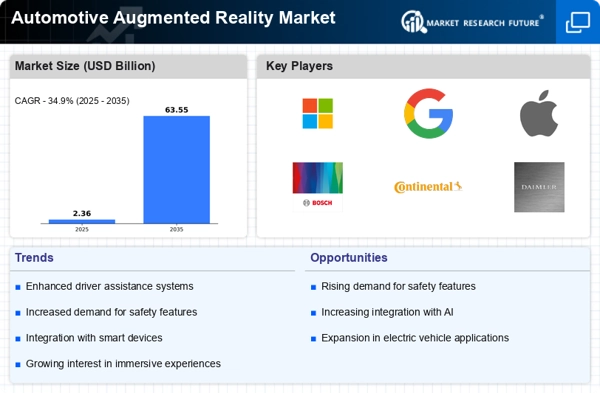Top Industry Leaders in the Automotive Augmented Reality Market
 *Disclaimer: List of key companies in no particular order
*Disclaimer: List of key companies in no particular order
Latest Company Updates:
Competitive Landscape of the Automotive Augmented Reality (AR) Market: Gearing Up for a Visionary Ride
This burgeoning landscape is teeming with established players and disruptive newcomers, all vying for a slice of the pie. Let's buckle up and explore the competitive terrain, dissecting key player strategies, market share analysis factors, and emerging trends shaping the future of automotive AR.
Key Players, Diverse Strategies:
Tech Giants: Google, Apple, and Microsoft, armed with advanced AR platforms and software expertise, are forging partnerships with automakers to integrate their technology into head-up displays (HUDs) and infotainment systems. Google's Waymo leads the pack with its AR-powered autonomous driving technology.
Automotive OEMs: Traditional carmakers like BMW, Mercedes-Benz, and Audi are actively investing in in-house AR development and partnering with tech players. BMW's concept car, Vision iNEXT, showcases an immersive AR experience for navigation and driver assistance.
Tier 1 Suppliers: Bosch, Continental, and Denso, long-standing giants in automotive components, are developing AR-enabled HUDs and driver assistance systems. Continental's Head-Up Display Plus projects vital information onto the windshield, enhancing safety and reducing driver distraction.
Start-ups: Disruptive innovators like WayRay and Magic Leap are injecting fresh ideas with next-generation AR displays and software solutions. WayRay's holographic AR technology promises a seamless integration of virtual information into the driver's field of view.
Market Share Analysis: A Multifaceted Puzzle:
Technology Leadership: Companies with cutting-edge AR platforms and software hold an edge. Google's ARCore and Apple's ARKit are widely adopted, providing a strong foundation for automotive applications.
Strategic Partnerships: Collaborations between tech giants and OEMs foster faster development and market penetration. Partnerships like BMW and Microsoft, or Waymo and Jaguar Land Rover, leverage each other's strengths.
Regional Focus: Asia-Pacific region, driven by China's rapid automotive growth and tech advancements, is expected to be the fastest-growing market. North America and Europe, however, maintain a lead in AR technology development and adoption.
Product Portfolio Mix: Offering a diverse range of AR applications, from navigation and driver assistance to entertainment and personalization, can attract a wider customer base. Companies like Bosch, with its comprehensive AR HUD solutions, exemplify this strategy.
New and Emerging Trends: Vision Beyond the Windshield:
AR HUD Evolution: Beyond basic navigation arrows, advanced AR HUDs are incorporating real-time traffic updates, pedestrian and obstacle warnings, and even augmented reality gaming experiences.
Beyond Windshield Display: AR technology is venturing beyond HUDs, integrating into mirrors, windows, and even seats to create a truly immersive in-vehicle experience.
Personalization: AR interfaces are becoming increasingly personalized, adapting to individual driver preferences and learning driving patterns for a more intuitive experience.
Safety at the Forefront: AR-powered driver assistance systems like lane departure warnings and blind-spot monitoring are gaining traction, promising to significantly reduce road accidents.
Overall Competitive Scenario: A Dynamic Race with No Finish Line:
The automotive AR market is a dynamic dance between established players and agile newcomers, all jostling for dominance. Success hinges on continuous innovation, strategic partnerships, and a laser focus on enhancing driver safety and experience. As technology evolves and consumer expectations rise, the race for market leadership will only intensify, pushing the boundaries of what's possible on the road ahead.
Delphi Automotive (Ireland):
• Date: October 26, 2023
• Source: Delphi press release
• Development: Announced partnership with Waymo to develop AR displays for autonomous vehicles, providing drivers with contextual information about their surroundings and enhancing passenger experience.
Panasonic (Japan):
• Date: November 15, 2023
• Source: TechCrunch article
• Development: Unveiled prototype AR glasses for drivers, featuring integrated navigation, blind spot detection, and heads-up display of vehicle information.
Hyundai Motors (South Korea):
• Date: September 5, 2023
• Source: Hyundai Newsroom
• Development: Showcased "Genesis Augmented Reality HUD" at CES 2023, projecting driving information and surrounding environment onto the windshield for a safer and more informed driving experience.
BMW (Germany):
• Date: December 12, 2023
• Source: BMW blog post
• Development: Introduced "BMW Mixed Reality Drive" system in their iX Flow concept car, allowing drivers to customize the interior environment with AR projections onto various surfaces.
Top listed global companies in the industry are:
Delphi Automotive (Ireland)
Panasonic (Japan)
Hyundai Motors (South Korea)
BMW (Germany)
Alphabet (US)
Robert Bosch GmbH (Germany)
Denso (US)
Garmin International (US)
Continental AG (Germany)









